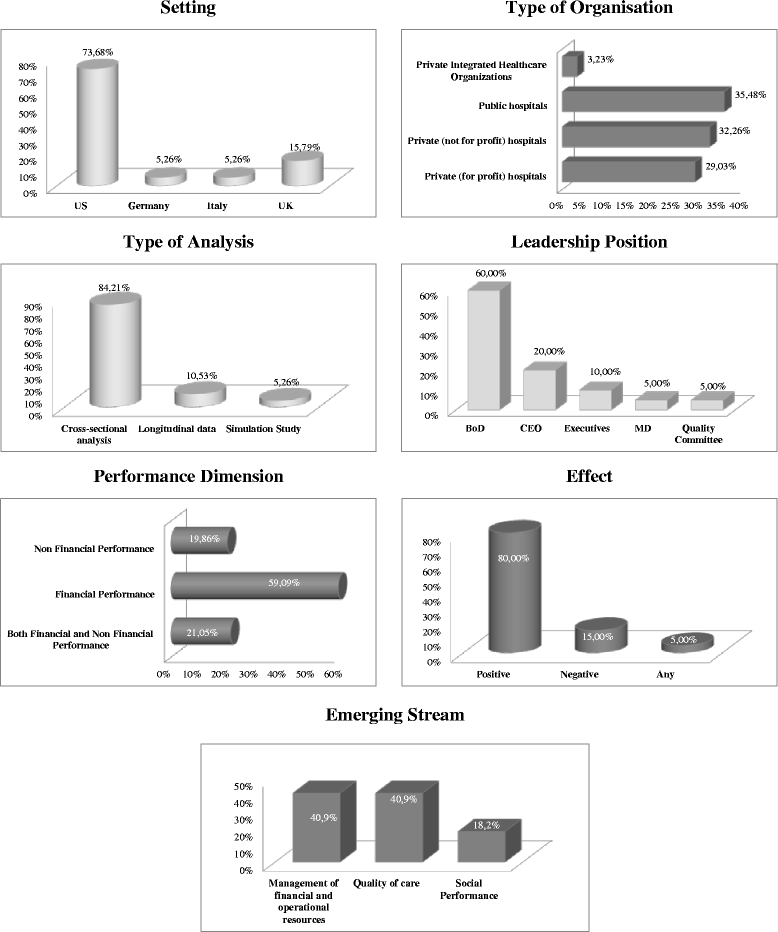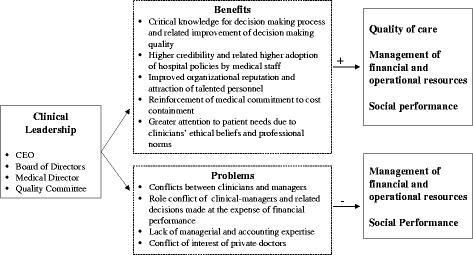Clinical leadership and hospital performance: assessing the evidence base
- PMID: 27230873
- PMCID: PMC4896259
- DOI: 10.1186/s12913-016-1395-5
Clinical leadership and hospital performance: assessing the evidence base
Abstract
Background: A widespread assumption across health systems suggests that greater clinicians' involvement in governance and management roles would have wider benefits for the efficiency and effectiveness of healthcare organisations. However, despite growing interest around the topic, it is still poorly understood how managers with a clinical background might specifically affect healthcare performance outcomes. The purpose of this review is, therefore, to map out and critically appraise quantitatively-oriented studies investigating this phenomenon within the acute hospital sector.
Methods: The review has focused on scientific papers published in English in international journals and conference proceedings. The articles have been extracted through a Boolean search strategy from ISI Web of Science citation and search source. No time constraints were imposed. A manual search by keywords and citation tracking was also conducted concentrating on highly ranked public sector governance and management journals. Nineteen papers were identified as a match for the research criteria and, subsequently, were classified on the basis of six items. Finally, a thematic mapping has been carried out leading to identify three main research sub-streams on the basis of the types of performance outcomes investigated.
Results and contribution: The analysis of the extant literature has revealed that research focusing on clinicians' involvement in leadership positions has explored its implications for the management of financial resources, the quality of care offered and the social performance of service providers. In general terms, the findings show a positive impact of clinical leadership on different types of outcome measures, with only a handful of studies highlighting a negative impact on financial and social performance. Therefore, this review lends support to the prevalent move across health systems towards increasing the presence of clinicians in leadership positions in healthcare organisations. Furthermore, we present an explanatory model summarising the reasons offered in the reviewed studies to justify the findings and provide suggestions for future research.
Keywords: Clinical leadership; Hospital performance; Narrative review.
Figures
References
-
- Mintzberg H. The Structuring of Organizations. Englewood Cliffs: Prentice Hall; 1979.
-
- Hood C. A public management for all seasons? Public Adm. 1991;69:3–19. doi: 10.1111/j.1467-9299.1991.tb00779.x. - DOI
-
- Lindlbauer I, Winter V, Schreyogg J. Antecedents and Consequences of Corporatization: An Empirical Analysis of German Public Hospitals. J Public Adm Res Theory. 2015;Early View:1–26.
-
- Aidemark LG, Lindkvist L. The vision gives wings. A study of two hospitals rus as limited companies. Manag Account Res. 2004;15:305–318.
-
- Saltman R, Durán A, Dubois H. Governing public hospitals. Reform strategies and the movement towards institutional autonomy. Copenhagen: WHO. 2011.
Publication types
MeSH terms
LinkOut - more resources
Full Text Sources
Other Literature Sources
Medical




